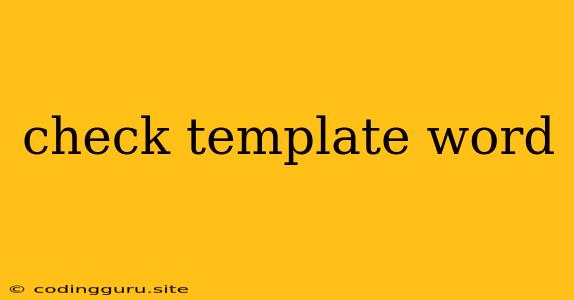How to Check a Word Template for Errors and Ensure a Professional Look
Microsoft Word templates are incredibly useful for creating consistent and professional documents, but sometimes they can cause unexpected issues. Whether you're working with a template you found online or one you created yourself, it's crucial to check the Word template thoroughly before using it.
Here's a guide on how to check a Word template for errors and ensure it produces the document you expect:
Why Check Your Word Template?
- Mistakes: Templates can contain hidden errors, like incorrect formatting, missing text, or even malicious code.
- Customization: Templates are meant to be adapted to your specific needs. Checking ensures you understand how to customize the template effectively.
- Consistency: If you're using a template for multiple documents, you want to make sure it maintains consistency in formatting and layout.
How to Check a Word Template
Here's a step-by-step process to check your Word template for errors and ensure its functionality:
1. Open the Template:
- Open the Word template file (usually a .dotx or .dotm file).
2. Review Formatting:
- Examine Fonts and Styles: Check that the font styles, sizes, and colors are as expected. Make sure they are consistent throughout the template.
- Verify Margins and Page Setup: Inspect the margins, page orientation, and page numbers. Adjust them if necessary.
- Inspect Table and List Formatting: Ensure that tables and lists align properly and have the correct formatting.
- Check for Hidden Content: Use the "Show/Hide" button (paragraph symbol) in the "Home" tab to reveal any hidden formatting marks.
3. Test Placeholder Content:
- Replace Placeholder Text: Templates often use placeholder text (like "Your Name" or "Date"). Replace this placeholder text with your own content to see how it looks.
- Test Field Codes: Templates might use field codes for dynamic content like dates, page numbers, or other automatic elements. Ensure these codes work as expected.
- Check Images and Graphics: Make sure all images and graphics are present and display correctly. Adjust their size and positioning as needed.
4. Check for Macros and Scripts:
- Enable Macros: If the template includes macros, you'll need to enable them to see how they function.
- Examine Macros: If you're not familiar with macros, be cautious about enabling them, as they can potentially introduce security risks.
- Disable Macros: If you're unsure about the macros, it's best to disable them. You can do this by going to "File" > "Options" > "Trust Center" > "Trust Center Settings" > "Macro Settings" and selecting "Disable all macros with notification."
5. Save a Copy of the Template:
- Create a Duplicate: Make a copy of the template before making any changes. This allows you to revert to the original template if needed.
6. Customize the Template:
- Add or Remove Content: Add or remove content sections based on your needs.
- Adjust Styles: Modify font styles, sizes, colors, and other formatting elements to match your preferences.
- Insert New Elements: Include any additional elements like charts, tables, or images.
7. Save Your Changes:
- Save as a New Template: Save your customized template with a new name to keep the original template intact.
8. Test the Template:
- Create a Document: Open a new document and choose your customized template.
- Review the Document: Check the overall layout, formatting, and content. Make sure everything is correct and meets your expectations.
Tips for Checking Word Templates
- Use the "Print Preview" Feature: Before finalizing the template, use the "Print Preview" feature to see how the document will look when printed.
- Seek Assistance: If you encounter any issues, don't hesitate to seek help from online forums, Microsoft support, or a professional.
Examples of Common Word Template Errors:
- Incorrect Page Orientation: The template might default to landscape orientation while you need portrait.
- Missing or Incorrect Header and Footer: The template might not have a header or footer, or the header and footer might be formatted incorrectly.
- Text Overlapping: Text might overlap with images or other elements, especially if the template uses a lot of graphics.
- Hidden Formatting Marks: Hidden formatting marks can disrupt the flow of the document and make it difficult to read.
Conclusion
Thoroughly checking your Word template is a vital step in ensuring that your documents are professional, consistent, and error-free. By following these steps, you can identify and fix any potential issues before using the template for important projects. Remember, a well-checked template will save you time and effort in the long run and help you create high-quality documents.
